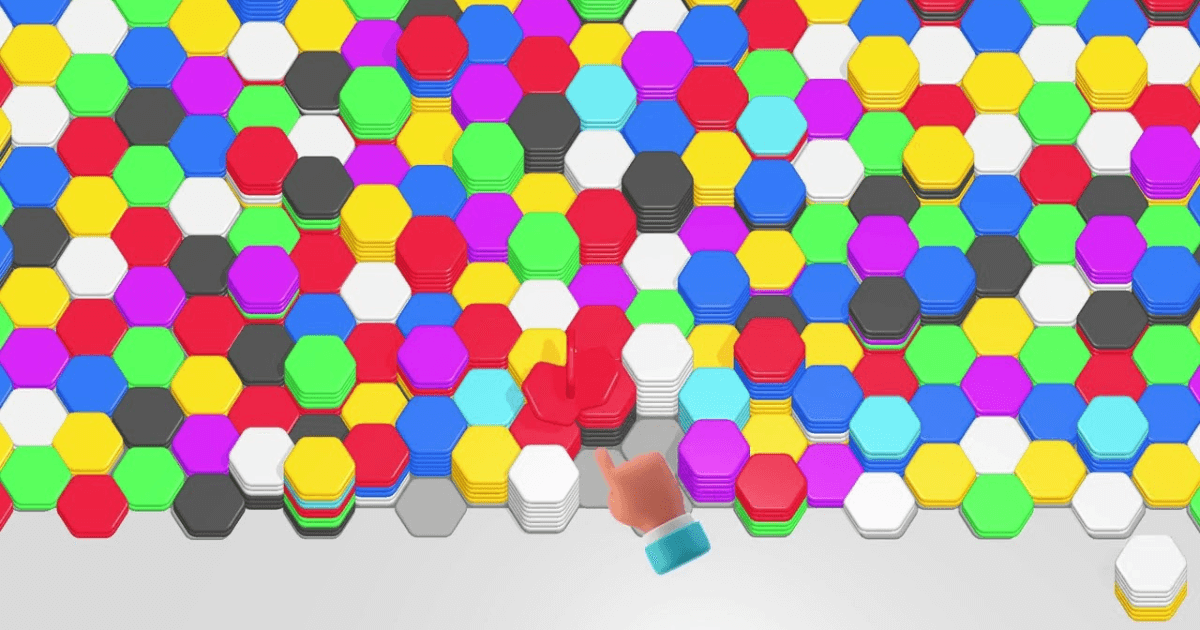“Why are there so many fake mobile game ads that show gameplay different from the actual games?”
“How come mobile games are pretty much allowed to advertise falsely?”
“Why do game publishers lie about the gameplay in their ads?”
Mobile gaming forums are flooded with questions like these, and each of them is completely justified. Indeed, in the last couple of years, we are witnessing a rise in fake and questionable mobile game ads.
In this article, we will give you answers to all of these questions and more!
Fake Mobile Game Ads Examples
There’s no talking about fake mobile game ads without mentioning Playrix.
In October 2020, Playrix became the first publisher whose ads got banned as misleading by Advertising Standards Authority (ASA). This news soon spread like wildfire in the mobile gaming industry.
Yet, this didn’t make Playrix give up on this practice.
Instead, to get rid of the ban, they modified their games to fit the ads.
With this in mind, let’s go over some famous examples of fake mobile game ads, starting with one from Playrix.
Homescapes
Homescapes is a game notoriously known for its misleading ads. These ads feature the game’s protagonist, Austin, in different situations.
In most cases, they put the character in dangerous situations for players to rescue him.
To make this happen, they need to pull pins, drag and drop certain items or answer quiz-style questions.

Source: Youtube
For example, one of the ads portrays Austin next to a clogged toilet that’s flooding the bathroom. To save him, players need to pull the right pin and get him the right tool. The onscreen hand (the player) then pulls the wrong pin, providing him with a hammer instead of the plunger.
Silly mistake, right?
That’s exactly what they want players to think. This move defies common sense to draw the players’ attention. Such ads are called “fail ads” and they are a completely legit way of attracting players.
The real issue lies in misleading mechanics in their ads.
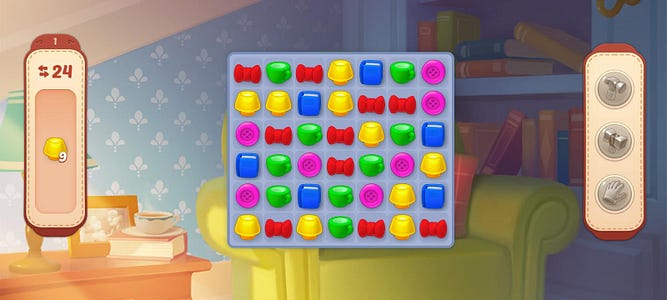
Homescapes’ actual core gameplay
This game is a match-3 game with narrative and decoration meta layers. Pulling pins and saving the protagonist is not what the game is really about.
Still, they get away with these ads.
The thing is, these mechanics actually exist in the game — just not as a part of the core gameplay. They appear in the form of mini-games.
Before the ban, these existed in their games but appeared rarely. Afterward, the developers made them appear more frequently and earlier in the game.
Just like that, Playrix solved its legal issues.
Hero Wars

Source: Youtube
Hero Wars is an idle RPG game with automated battles.
Yet, the ads for this game make it look like some sort of battle puzzle.
These ads usually feature Galahad, the game’s main character as he battles monsters. Others put him on a mission of saving his beloved princess. All of this matches the game’s theme. To display these happenings, the ads rely on drag-and-drop actions, as well as “pull-the-pin” mechanics.
The problem?
Just like in Homescapes, these mechanics don’t represent actual core gameplay.

Hero Wars’ actual core gameplay
Interestingly, when players launch the game, the first thing they see is the gameplay from the ads. This is basically an extension of the game’s advertising strategy. Soon enough, players realize that the core gameplay is something completely different.
The mechanics from the ads only appear as mini-games in bonus levels. This happens rarely but serves its purpose — as long as they are a part of the game, it’s technically not false advertising.
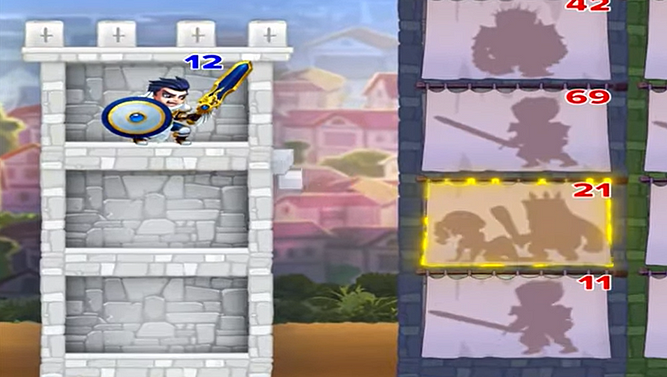
Source: Youtube
On top of this, in some Hero Wars ads, certain characters are over-sexualized. The advertiser deliberately does this to catch the viewers’ attention. Of course, this is not a part of the game.

Source: Reddit
Finally, some Hero Wars ads even feature dramatic storytelling. For example, they show the game’s hero being cheated by his wife, or vice-versa, and the female character becoming the hero of the story. Obviously, these stories have no connection to this fantasy-themed battle game.
It’s hard to completely understand the strategy here, but the developers are probably testing ways to appeal to different audiences. Especially the ones not immediately familiar or attracted by the fantasy genre.
Lily’s Garden
This match-3 puzzle also uses misleading ads to engage viewers, but in a different way than the games above.
The ads for this game look like movie snippets.
The gameplay? No, not really.
Lily’s Garden ads can make people believe they are about to play some kind of immersive visual novel. In reality, it’s just a simple match-3 decoration game with narrative as a side part.
To make them even less related to the actual game, Lily’s Garden ads are also quite bizarre.
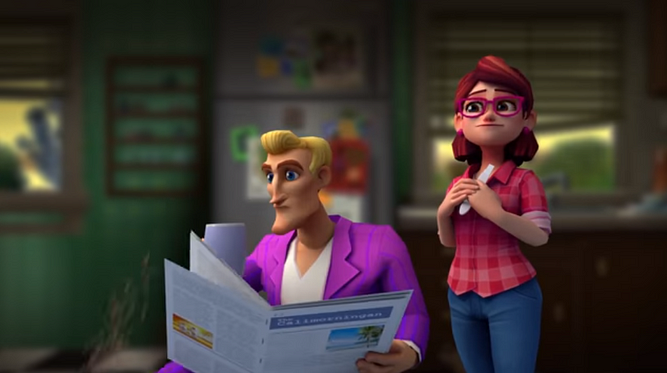
Source: Youtube
One of the game’s viral ads starts with Lily holding a positive pregnancy test. After telling her boyfriend, he runs away on his motorcycle like a chicken. You might think that’s the twist, but then the real shocker kicks in — Lily casually wipes off the line from the test, implying that she faked pregnancy.
Now, that’s a twist no one saw coming.

Source: Youtube
In some other ads for this game, we can see Lily’s boyfriend flirting with her mom, her walking in on them while “hanging out on the couch”, Lily enjoying sitting on a washing machine a bit too much, etc.
When players come across ads like these, they will have a hard time forgetting them, that’s for sure.

Lily’s Garden’s actual core gameplay
The goal of all this is to draw the attention of a wide, drama-hungry audience to a simple match-3 game. Also, even though the game has a storyline, it is not nearly as dramatic as in the ads.
Common Types of Fake Mobile Game Ads
What is considered a fake mobile game ad exactly?
These are all ads that involve content that is unrelated to the game they are supposed to represent.
If you analyze the ad examples above, you may notice some repeating patterns. This is because some forms of fake mobile game advertising are more common than others.
Here comes the list.
1. Pin-Pulling (How to Loot)
Ads that typically display a game character that needs rescuing. The character is surrounded by movable pins, and the players’ moves determine their fate.
The pins usually block some kind of threat like water, toxic waste, lava, or monsters. In other cases, they stand in the way of indispensable items for the protagonist, such as a weapon or a tool. Next, the onscreen hand (the player) pulls a pin to try and save them. In a lot of cases, they make the wrong move.
The pin-pulling mechanic is also known as “how to loot”. It was originally designed specifically for advertising purposes, not for actual games.
2. Drag and Drop Actions
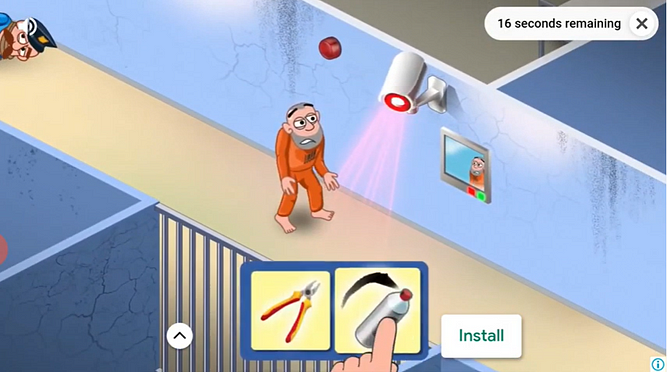
Source: Youtube
These fake mobile game ads display characters in situations that can be fixed. For example, a broken chair, sudden rain, or escaping jail with security cameras.
To resolve these issues, the player gets a selection of items to choose from. Once they pick out an item, they need to drag it to the character. One of them is usually completely logical, while the other one isn’t.
In a lot of cases, the “player” selects the wrong item and the next thing that appears on the screen is a big “FAIL” sign.
3. Survival in Extreme Environments
This ad type works similarly to drag-and-drop action ads.
The main difference is that, here, the characters are placed in some kind of extreme situation. For example, they are starving in a desert, need to escape a fire, etc.
The player’s task is to “play the hero” and rescue the characters. For that to happen, they need to choose the right item from the selection they get.
4. Exaggerated Ads
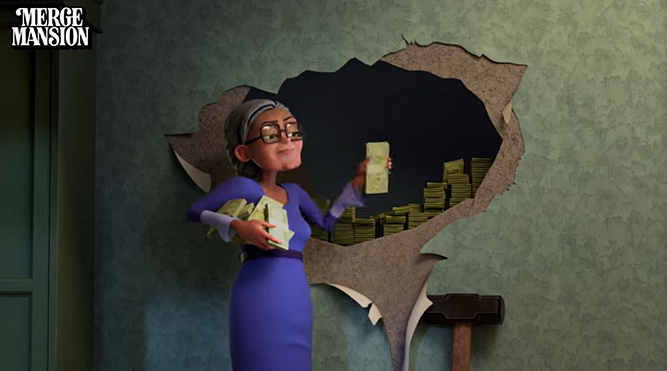
Source: Youtube
Judging by their ads, one might think that there are many mobile games with impressive 3d graphics.
Oh, if only this were true.
This happens because some companies seem to invest more in making ads for their games than actually developing them. As a result, they run ads that are completely untrue to the game’s look and feel. For example, cinematic ads that resemble movies or series.
Exaggeration doesn’t just appear in the form of graphics, but also in ad storylines. Some game advertisers use overly dramatized ads just to catch people’s eye. In reality, these stories have almost nothing to do with the advertised game.
5. “Only 1% Can Do This”
Hyper-casual games are not immune to false advertising either.
In ads for hyper-casual games, we can frequently see some misleading practices. This includes captions like “only 1% can solve this”, “99% will fail”, “only 2% reach green color”, etc.
Some other popular misleading phrases convince players the game is incredibly difficult. For example, “you can’t do this”, “you are not able to save the hero”, and “don’t try this”.
All these captions are merely attention grabbers, and they are obviously not true. When it comes to those about reaching a certain color, this color is frequently not even in the ad.
Yet, we can’t say that all such ads are completely fake. The ads for hyper-casual games usually feature actual gameplay or make it at least similar to the one in the game.
6. Oversexualized Ads
Some advertisers use sexual motives in their ads to lure people into installing their games.
Such ads are not only fake but also problematic.
A vast majority of these ads feature overly sexualized and objectified women. This can make a lot of viewers feel offended and humiliated.
In most cases, these features don’t appear in the advertised games. Even if they do, this is rare and, well, still troublesome.
Why do Advertisers Use Fake Mobile Game Ads?
Wherever there is a mobile game that uses fake ads, there are also some angry reviews in its app store listings.
Despite that, a lot of game advertisers never back down from this approach. Here are the main reasons why fake mobile game ads are so popular.
Reason 1. The Results
Even if as many as 95% of players abandon a falsely advertised game in the first 5 minutes, there will still be 5% that will continue playing it. This can be a sufficient percentage to make this strategy profitable.
It’s like casting a wide net into the sea and letting the majority of the fish escape.
The ones that stick around are the ones that matter most.
It all depends on the numbers.
As long as the CPI (cost per install) is low enough, and ARPU (average revenue per user) is high enough, the advertising strategy is sustainable. For this reason, the advertisers don’t pay much attention to the disappointed players and the game’s reputation.
Reason 2. Making It Seem New and Appealing
A lot of games are based on tried and true mechanics that have been popular for years. The problem is, that when people see ads with such mechanics, they frequently don’t pay much attention to them.
For example, when they see match-3 gameplay, a lot of them see it as “just another version of Candy Crush”.
To avoid such labels, marketers use fake ads to give games shiny new packaging. For example, by creating cinematic ads filled with captivating stories.
Moreover, some fake mobile game ads are appealing because they are incredibly weird. By looking completely off, over-the-line, or simply wrong, a part of the users will engage with them just to check what’s going on.
All this will drive a lot of users to install a game — only to find out it’s actually based on the good old match-3 mechanic.
Reason 3. They Drive Conversations

Source: MemeZila
We’re writing about them. Players talk about them in the app stores, on forums, and on social media.
Heck, there are even memes about them.
Fake mobile game ads sure create a lot of buzz.
All these loud reactions help advertised games gain visibility. Even though they are usually mentioned in a negative context, the ads for these games frequently go viral.
The advertisers are obviously driven by the good old saying:” All publicity is good publicity”.
Reason 4. Standing Out
Getting noticed in the overcrowded mobile game market is difficult.
Especially for the small ones.
Large companies have more resources, power, and a strong brand. All of this gives them an advantage when promoting new games. For this reason, small or new studios often decide to use deceptive advertising to stand out from the competition and put their new games under the spotlight.
The Consequences of Using Fake Mobile Game Ads
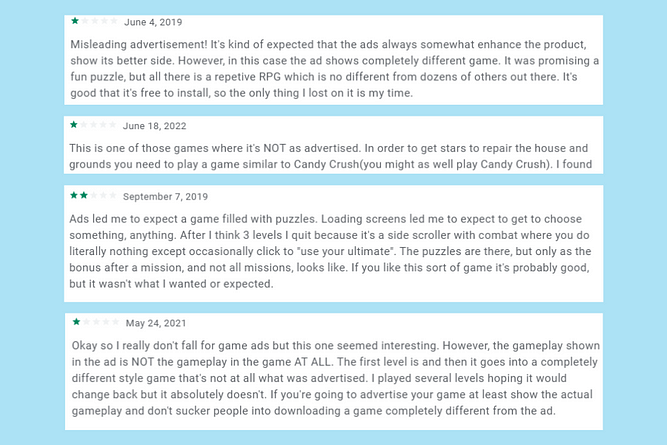
Is false advertising really worth it?
If all this talk about false advertising made you want to consider it, you should know that this strategy can backfire badly. Here are just some negative consequences this practice can bring:
- frustration and disappointment when users start playing the game
- bad app store rating and numerous negative reviews
- the majority of players will churn quickly
- a low percentage of long-term users
- tarnished reputation
- can make users turn to competitors instead
How Are Fake Mobile Game Ads Allowed?
At the start of the article, we touched on this issue briefly, but we feel like it deserves a deeper dive.
How are game advertisers getting away with fake advertising?
The #1 factor is profit.
This one is pretty simple. As long as the advertisers invest large amounts of money into running fake ads, the ad networks profit. Hence, it’s not in their best interest to take them down.
The #2 big factor is the fact that these games are free-to-play.
Legally, misleading advertising is defined as deceiving rational consumers into making a purchase. Since mobile games are free to install, they don’t fall into this category. Upon the install, users can realize a game is different before spending money on it.
No one is going to spend hundreds of dollars on a game and later complain it’s not what they saw in the ads. Since there is usually no financial damage, legal authorities consider this issue a low priority.
Why Don’t They Just Make Games From Those Popular Ads?
This question naturally arises when discussing fake mobile game ads.
And it’s a fantastic one.
The answer is — multiple publishers have done exactly this. Here are some games based on fake ad mechanics that got over 50 million Google Play installs:
- Hero Rescue (pin-pulling game)
- Hustle Castle (drag-and-drop actions game)
- How to Loot — Pin Pull & Hero Rescue (pin-pulling game)

Hero Rescue Google Play Screenshots
Judging by their install numbers, it seems like there is a relatively big playerbase for games like these. Yet, unlike some of their rivals who use fake ads, none of these games became huge.
Moreover, for now, no major company like Playrix has shown interest in pursuing this kind of strategy. It seems like, for them — this is just about marketing.
Are Fake Mobile Game Ads Still A Trend in 2023?
Like it or not, fake game ads are still a massive trend.
Not only are they still around, but they are evolving as we speak.
With more and more players complaining about fake ads, advertisers and app owners are becoming extra dedicated to camouflaging this practice.
How do they do it?
By extending the illusion that the game is as advertised. To achieve this, they introduce snippets of fake gameplay in the entire onboarding process — from app store screenshots to tutorials and mini-games.
Instead of abandoning the practice of using fake mobile game ads, today, marketers are determined to make them work even better in their favor.
TikTok and Fake Game Ads
On TikTok, fake advertising has become more sophisticated than on any other channel.
To understand what’s going on, you should be aware of a recent TikTok trend — deinfluencing.
To define, deinfluencing is a strategy where content creators tell their followers why they shouldn’t use a certain product. For example, that they shouldn’t install a game because it advertises falsely.
Sounds like a noble cause, right?
In many cases, it’s exactly the opposite. Some content creators start their videos by claiming they will expose fake ads for an XY game, seemingly deinfluencing.
However, they then proceed to play the game, sharing gameplay footage and saying things like “This is actually like in the ads”. By doing this, they trick people into downloading the game.
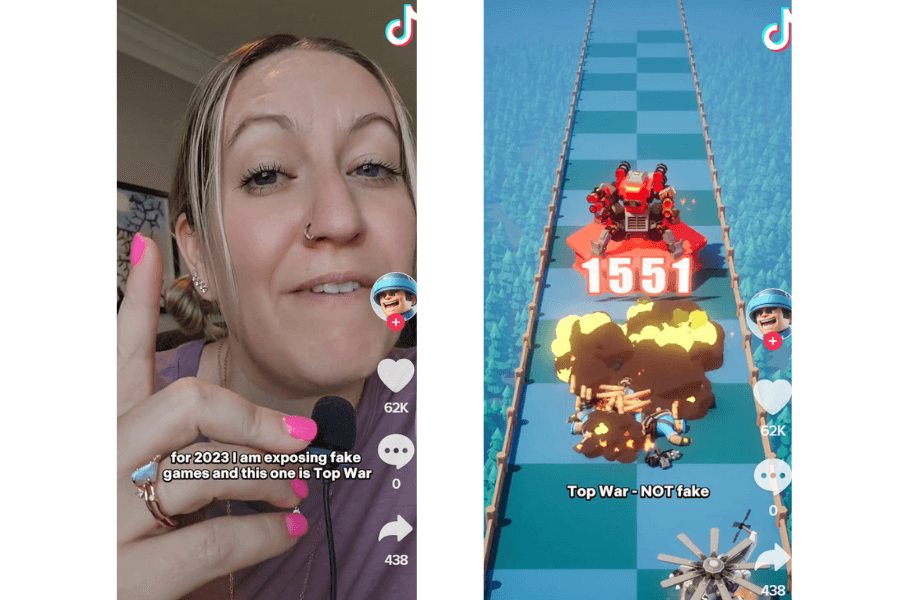
When players find out that these videos were misleading, this naturally results in a lot of backlash for both the creator and the game.
Is it worth it? We highly doubt it.
Fake Mobile Game Ads: Over to You
You’ve made it to the very end of our analysis of fake mobile game ads. Now, we want to hear from you.
What are your thoughts on false advertising? Do you believe that fake ads are here to stay? Let us know by leaving us a comment on social media.
Also, if you want to read more insightful articles like this one, make sure to subscribe to our newsletter!

